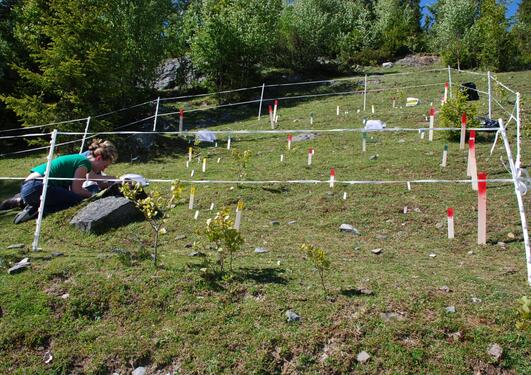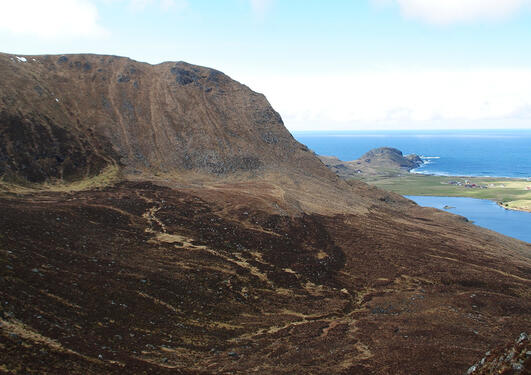EMERALD
Terrestrial ecosystem-climate interactions of our EMERALD planet

Hovedinnhold
Plants have changed the history of our "Emerald Planet". As David Beerling wrote in his 2017 book The Emerald Planet '[plants] regulate the cycling of carbon dioxide and water, influences the rate at which rocks erode, adjust the chemical composition of the atmosphere, and affect how the landscape absorbs or reflects sunlight.' They are 'not silent witnesses to the passage of time but dynamic components that shape and are, in return, shaped by the environment.' Shaping and being shaped, vegetation operates in feedbacks in the climate system, involving also the atmosphere, soils, and the hydrological cycle.
The scientific objective of EMERALD is to improve representation of high-latitude ecosystems and their climate interactions in the Norwegian Earth System model (NorESM) by integrating data and knowledge from empirical ecosystem research in model parameterisation, development, and testing.
Expanding from established collaborations, EMERALD will integrate existing activities among key partners and provide added value through critical mass, joint fieldwork and experiments, co-ordinated modelling efforts, and novel approaches. This requires a rigorous review of existing parameterisations across a range of scales. EMERALD facilitates beter use of relevant data and observations and implementation of key processes in NorESM. We expect to significantly advance the representation of high-latitude terrestrial ecosystems, offering novel parameterisations and structural updates to improve current land surface schemes - with the potential to yield significant improvements in NorESM, including impacts and feedback to terrestrial ecosystems.
EMERALD will "feed" a community land model (CLM) and "challenge" it with observtional data from cold environments to implement improved representations adapted for each specific region. This model development strategy, which includes process-based mechanistic modelling, is the core of Work-Package (WP) 1. A critical factor for its successful application is the availability of relevant observational data, vital both for formulating underlying processes and relationships, and for feeding and challenging the CLM. A critical resource towards this is the wealth of data from decades of vegetation and ecosystem research from across Norway, including but not limited to work by EMERALD partners, much of which has focused on impacts of climate change, and which not yet has been brought together in a systematic way. EMERALD thus facilitates a broader national collaboration and data synthesis across the community, while also adding a focus to the reverse relationship: the impact of vegetation on climate. Based on this data resource, WP2 supports WP1, but also contributes stand-alone research in the form of process studies, and upscaling by combining observations across methods and parameter space. WP1 outcomes will be used in WP3, which explores the effects of model improvements in NorESM.
Work-Packages
WP1: Land surface model evaluation and improvement
WP1 will validate several recent improvements in land surface models (LSMs) for northern environments using our observation and experimental data (see Table). Elements missing in NorESM/CLM known to be key components of northern ecosystems will be added. If the models fail to predict critical patterns accurately (e.g. snow, C, cycle), improvements will be sought in process representation and scale gaps between measurements and models.
| Project | Infrastructure | Environment | Vegetation character | Fluxes | Images | |||||||||||
| Name | Region | # Sites | Years of data | Treats | Climate | Snow | Soil | PFT | Comm. | FT | Demog. | Water | Temp. | C | Near | Remote |
| SIOS+ WICLAP | High Arctic | 19 | 1-14 | C, T | T, P, W | S | c | C | c | |||||||
| InterAct | High Arctic | 1 | 7 | C | T, P, W | S | S | S | C | C | C | |||||
| SatPerm+ | High Arctic | 1 | 20 | C | T, P, W | S | M, N, S | S | S | C | C | C | C | |||
| CryoMET | High, Low Arctic | 2 | 6 | C | T, P, W | S | M, N, S | S | ||||||||
| Feedback | Low Arctic | 1 | 3 | C, T | T, P, w | S | M, N, S | S | S | S | A | A | A | |||
| PermaNor | Low Arctic | 4 | 3 | C | T, P, W | S | S | s | ||||||||
| Winter grazing | Low Arctic | 32 | 19 | C, T, G | T, P, W | s | M, N, S | c | S | c | ||||||
| LATICE | Alpine | 1 | 2 | C | T, P, W | S | M, N, S | A | A | A | A | A | ||||
| SeedClim+ | Boreal, Alpine | 12 | 10 | C, T, P, F, D | T, P, w | s | M, N, S | A | A | S | A | C | A | S | s | |
| ICOS Norway | Boreal Cont. | 1 | 2 | C | T, P, W | S | M, N, S | S | S | C | C | C | S | s | ||
| LandPress+ | Boreal Oceanic | 5 | 2-24 | C, T, P, F | T, P, w | s | M, N, S | A | A | S | C | A | S | s | ||
| NFI | Norway | 200,000 | 28 | C | t, p, w | s | A | a | ||||||||
| TerraBGP+ | Fennoscandia | Gridded | 4-9 | C | t, p, w | s | A | a | ||||||||
Table giving an overview over a subset of the existing field infrastructure, experiments, and observational systems that will be harnessed and extended for key empirical data in EMERALD (constituting an Arctic ecosystems testbed). The table summarises key Infrastructure (C=untreated/control conditions, T=Temperature, G=Grazing, P=Precipitation F=Plant Functional Types, D=Dispersal/distribution) and Environment (T=Temperature, P=Precipitation, W=Wind, S=Snow, M=soil moisture, N=soil nutrients, S=soil structure). The key ecosystem responses are summarised under Vegetation characteristics (plant functional type PFT; community Comm.; funtional traits FT; demography Demog.), Fluxes and Images. For each of these responses, C=continuously logged data, A=annual resolution data, and S=Single-point measurements. Lower-case letters signify remote or modelled data, otherwise measurements.
WP2: Improved process understanding from observations and experiments
WP2 harnesses research investments that already exist in the form of relevant data from past and current research and monitoring projects from across Norway and beyond (see Table). The EMERALD team is uniquely positioned to do this, as we collectively have access to a wealth of such projects. We will add key measurements and covariates to some of these sites or experiments to facilitate the integration and usage of the data, covering major drivers and response variables across key nature types and climatic gradients. The WP is broken down into a number of tasks.
Task 2.a Refining and mapping new Arctic alpine plant functional types (PFTs)
Task 2.b Vegetation dynamics
Task 2.c Plant hydrological processes
Task 2.d Albedo
Task 2.e Carbon cycle
Task 2.f Energy balance
Task 2.g Dataset compilation and coordination
WP3: Implementation in NorESM and quantification of feedbacks
In the fully coupled climate system, feedback processes cannot be seen in isolation. To gain understanding of the feedback potential of processes and new parameterisations in the terrestrial system, WP3 starts with off-line simulations (fixed atmospheric forcing). A high resolution (1x1 km) forcing dataset for Norway is established by downscaling ERA5 data with the weather research & forecasting (WRF) model for the period 1950-present. Running revised versions of the models CLM5BGC and CLM5FATES with this input allows testing against observed surface properties (from WP2). Tasks to be undertaken are:
Task 3.a Upscaling
Task 3.b Quantify biophysical and biogeochemical feedback strengths
Task 3.c Cloud-vegetation feedbacks
Task 3.d Carbon-Cycle feedbacks
Task 3.e Global climate sensitivity implications
WP4: Dissemination and communication
To inform the general public about the little-known interactions between ecosystems and the climate system, and improve the basis for climate change adaptation and further studies on the impacts of climate change on nature and society.
Key project participants
Frode Stordal, UiO
Lena Tallaksen, UiO
Hanna Lee, NORCE
Jarle Bjerke, NINA
David Lawrence, NCAR
Olav Skarpaas, UiO
Vigdis Vandvik, UiB
Terje Berntsen, UiO
Hui Tang, UiO
Norbert Pirk, UiO
Ryan Bright, NiBIO
Sebastian Westermann, UiO
Hege Hisdal, NVE
Anders Bryn, UiO
Frans-Jan Parmentier, UiO
Massimo Cassiani, NILU
Hanne Christiansen, UNIS
Kolbjørn Engeland, NVE
Hans Tømmervik, NINA
Ane Vollsnes, UiO

